Digital Signage: Confluence with built environments
by all | 1 August 2017 10:00 am
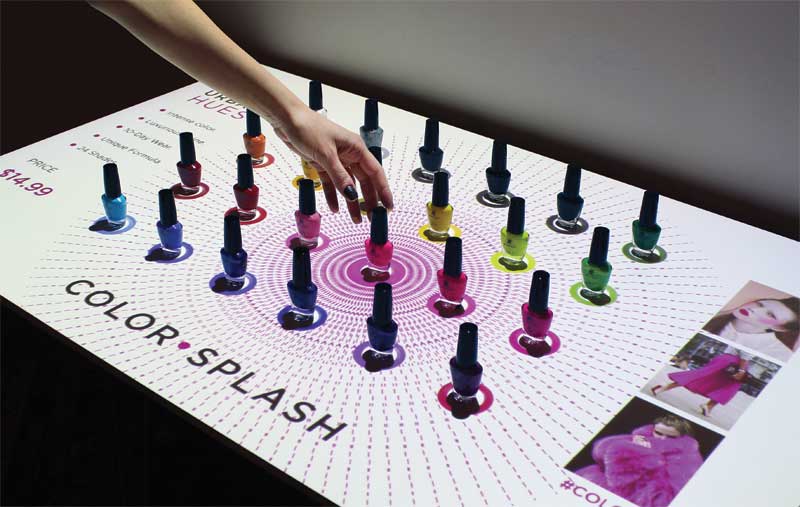 [1]
[1]Photo courtesy Perch Interactive
By Craig M. Berger
From large cities to small towns, digital signage deployments are expanding everywhere, due to reductions in costs and increases in ease of use and durability. As digital signage becomes more ubiquitous, however, the success of everything from pedestrian-facing kiosks to full light-emitting diode (LED) façades is leading to problems with visual clutter, especially where lower-quality messaging systems compete for space and the public’s attention.
At the same time as digital signage clutter is starting to become a major issue, the promise of more comprehensively integrating screens into retail and institutional spaces has not come to fruition, as organizations shy away from planned projects because they fear their messages will become invisible, particularly as the public focuses more on ‘personal’ screens—i.e. smartphones—than the ‘environmental’ screens around them.
All technological innovations go through this sort of transitional stage before they more fully mature with the development and implementation of industry best practices. Further advances will rely on leadership from sign companies, manufacturers, designers and other specialists, embracing the opportunity to move beyond the screens themselves to create exciting spaces that take better advantage of digital signage within a physical landscape.
Upgrading interactivity
Interactive digital map directories have been around for 40 years, but now many of them are declining in value, as the same functionality shifts onto smartphones.
Where directory kiosks can become relevant today is through greater ‘intelligence,’ given the capability to become more in tune with their environment through monitoring and by better tailoring content to visitors’ needs, including interaction with their smartphones.
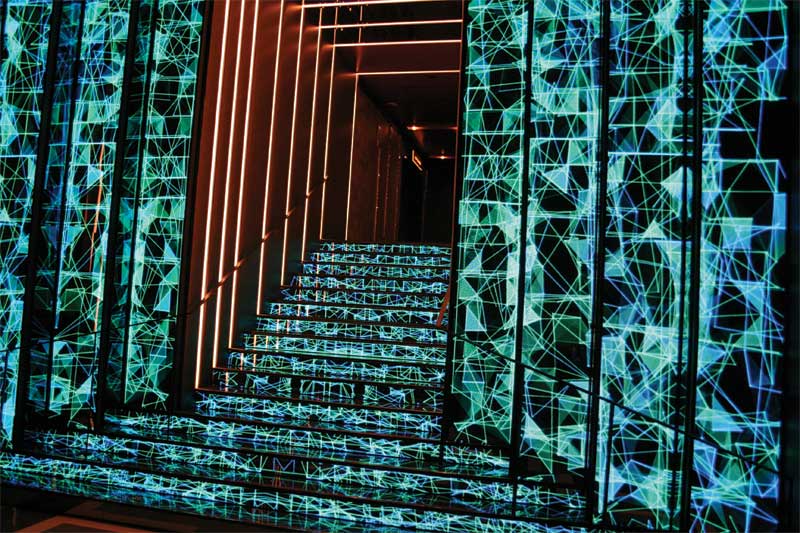 [2]
[2]Ottawa-based UTG Digital Media created a first-of-its-kind LED staircase for a nightclub in Las, Vegas, Nev.
Photo courtesy UTG Digital Media
Directories are also harder to ignore when they are designed to better standards and become landmarks within their environments. This is a question of combining the best attributes of interactive digital media and physical display structures.
By way of example, Gable Signs of Baltimore, Md., has introduced new free-standing directories for Simon Property Group’s shopping malls across the U.S., combining touch-interactive screens with wireless connectivity. The two companies worked together for more than a year to develop the enhanced units from scratch, including a new graphical user interface (GUI).
Strategically positioned in high-traffic areas, the 1.7-m (65-in.) high-definition (HD) liquid crystal displays (LCDs) ‘come to life’ whenever a shopper walks within a few feet of them. Users can find out what’s going on at the mall and find the fastest routes to take to reach various shops and services. They can then send those directions to their mobile devices via beacon, near-field communication (NFC), Short Message Service (SMS) or other wireless channel. There is also location-based marketing functionality, allowing brands to connect with customers with relevant, real-time information.
Another possibility for integrating innovative technology with an interactive directory would be to add augmented reality (AR), thus allowing dynamic content to appear overlaid on the physical environment.
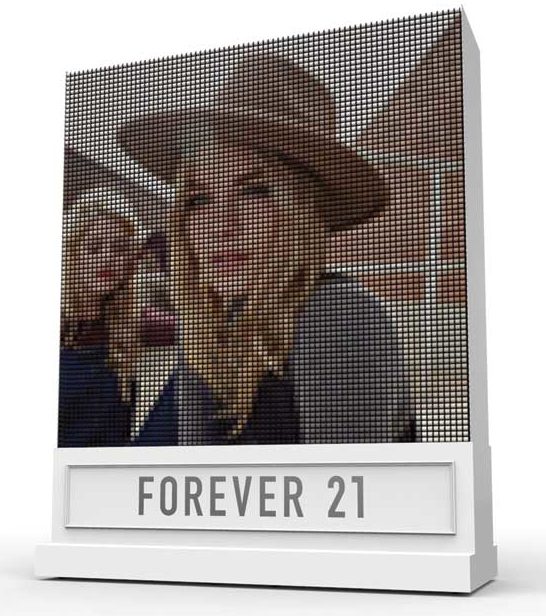 [3]
[3]Forever 21’s thread screen turned Instagram images into large-format physical art.
Photo courtesy Forever 21
Unique placemaking
As companies begin to realize digital signs do not in themselves command the same level of attention as before, due to competition with other screens and handheld devices, some of the more imaginative ones are taking the opposite path for beating ‘screen fatigue’ by combining digital signage with older technologies, such as moving lights, scrolling readerboards and even flip-disk displays.
In 2015, for example, technology agency Breakfast unveiled a ‘thread screen’ for clothing retailer Forever 21. The 907-kg (2,000-lb) machine used 6,400 spools of thread to display Instagram images carrying the hashtag #F21ThreadScreen, allowing customers to see their selfies turned into large-format art before their eyes.
The device was streamed live online 24 hours a day for one week on a dedicated website[4] and the participants received auto-edited videos via e-mail of their images being displayed on the screen.
Requiring some 200,000 custom-designed, engineered and manufactured parts, from motors and gears to lathed wooden spools, the thread screen machine was more than one-and-a-half years in the making, yet achieved a relatively simple effect. Each spool had a 1.7-m (5.5-ft) long piece of threaded fabric rolling over it, similar to a conveyor belt, with 36 colours of fabric available for display on the 80 x 80-pixel screen.
In this way, Breakfast and Forever 21 were able to achieve a dynamic display based on physical, motorized movement.
Dynamic buildings
Using LEDs and frame systems, architects are beginning to take advantage of the potential to combine low-resolution digital signage with components of buildings, including not just entire façades, as mentioned earlier, but also smaller features like entrances, floors and staircases. The technology for turning these surfaces into screens has substantially dropped in price, but the task of making them part of an overall design project requires a lot of co-ordination between architects, contractors and manufacturers.
ESI Design created a ‘digital streetfront’ for a building owned by Beacon Capital Partners within a growing technology hub in San Francisco, Calif. The update to the building’s façade created a distinctive visual landmark suitable for the neighbourhood’s new-tech vibe.
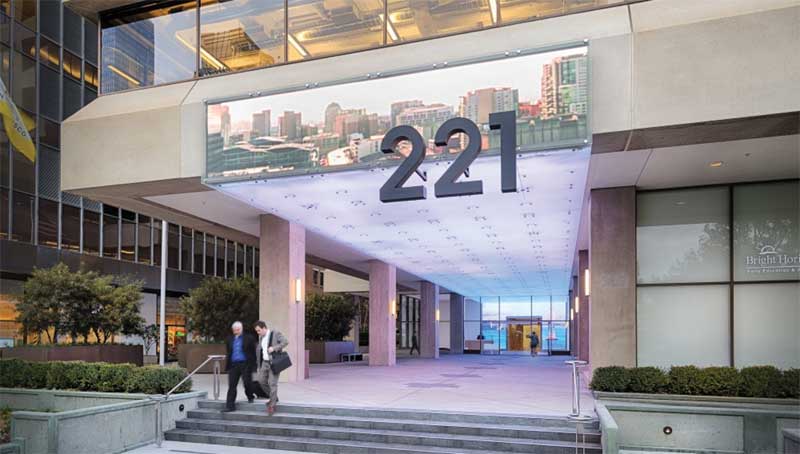 [5]
[5]ESl Design updated the façade of Beacon Capital Partners’ building with a digital display that extends all the way to the lobby.
Photo courtesy Beacon Capital Partners
The 38.4 x 7.6-m (126 x 25-ft) digital display stretches from the exterior façade to the interior lobby and showcases original content comprising nature-based Northern Californian motifs, including redwoods, beaches, waterfalls and poppies. Three different resolutions are seen from multiple viewpoints, with pixel pitch varying from 10 mm (0.39 in.) at streetfront to 124 mm (4.9 in.) along the exterior entryway ceiling to 5 mm (0.2 in.) inside the lobby, where even local weather data can be displayed. Etched glass was mounted over the LEDs to diffuse their light across the entire surface, creating a more seamless effect between these multiple resolutions.
Ottawa-based UTG Digital Media, meanwhile, recently topped the technical innovation category of the 2017 International Digital Signage Awards with the first-of-its-kind LED staircase display it created for the Jewel Nightclub in Las Vegas, Nev. The staircase’s risers were removed for the installation of LED ‘ribbon’ modules with polymethyl methacrylate (PMMA) protective covers, leaving the shock-absorbent top portion of each step unchanged. The resulting display can showcase images, text and/or video.
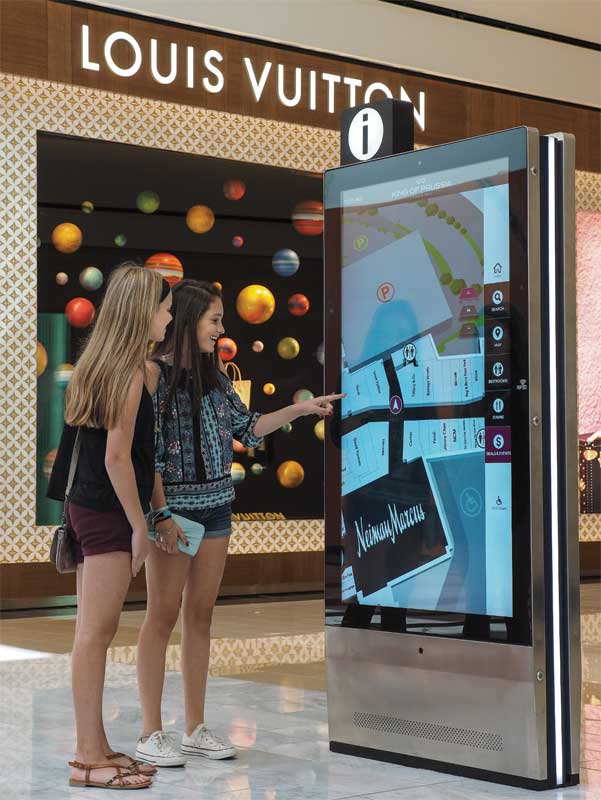 [6]
[6]Gable Signs and Simon Property Group worked together for more than a year to develop interactive directories for the latter’s shopping malls.
Photo courtesy Gable Signs
Reinventing the on-premise sign
While many municipal governments are seeking to crack down on existing digital signs because of their unattractive appearance, the more enlightened officials have tried instead to encourage better design. After all, better signs will bring greater acceptance.
One approach some of them have taken is to create codes that minimize the allowable portion of a sign for a digital screen, rather than ban screens outright. This ensures there is a strong physical presence to a sign, rather than the ‘lollipop’ effect of a simple pole-mounted screen, while still enabling dynamic content to be displayed.
Indeed, putting aside reduced prices, higher resolutions and ease of use, design improvements may well be the most important trend affecting the further adoption of digital signage. Industry best practices will create goodwill in communities and help ease restrictions, while broader innovations in design methods will help keep the medium fresh, relevant and an important component of the physical environment. This challenge is one where older sign design traditions and keen attention for detail will continue to be crucial.
Craig M. Berger is chair of the visual presentation and exhibition design department of the Fashion Institute of Technology’s (FIT’s) School of Art and Design and runs his own firm, Craig Berger Management Consulting, which assists fabricators, manufacturers and institutions with design-based marketing and education strategies. For information, contact him via e-mail at craigberger19@comcast.net[7].
- [Image]: https://www.signmedia.ca/wp-content/uploads/2017/07/perchtable.jpg
- [Image]: https://www.signmedia.ca/wp-content/uploads/2017/07/JEWEL-Stairs2.jpg
- [Image]: https://www.signmedia.ca/wp-content/uploads/2017/07/forever21_1-e1501091136934.jpg
- website: http://www.f21threadscreen.com
- [Image]: https://www.signmedia.ca/wp-content/uploads/2017/07/221main2.jpg
- [Image]: https://www.signmedia.ca/wp-content/uploads/2017/07/gable.jpg
- craigberger19@comcast.net: mailto:craigberger19@comcast.net
Source URL: https://www.signmedia.ca/digital-signage-confluence-with-built-environments/